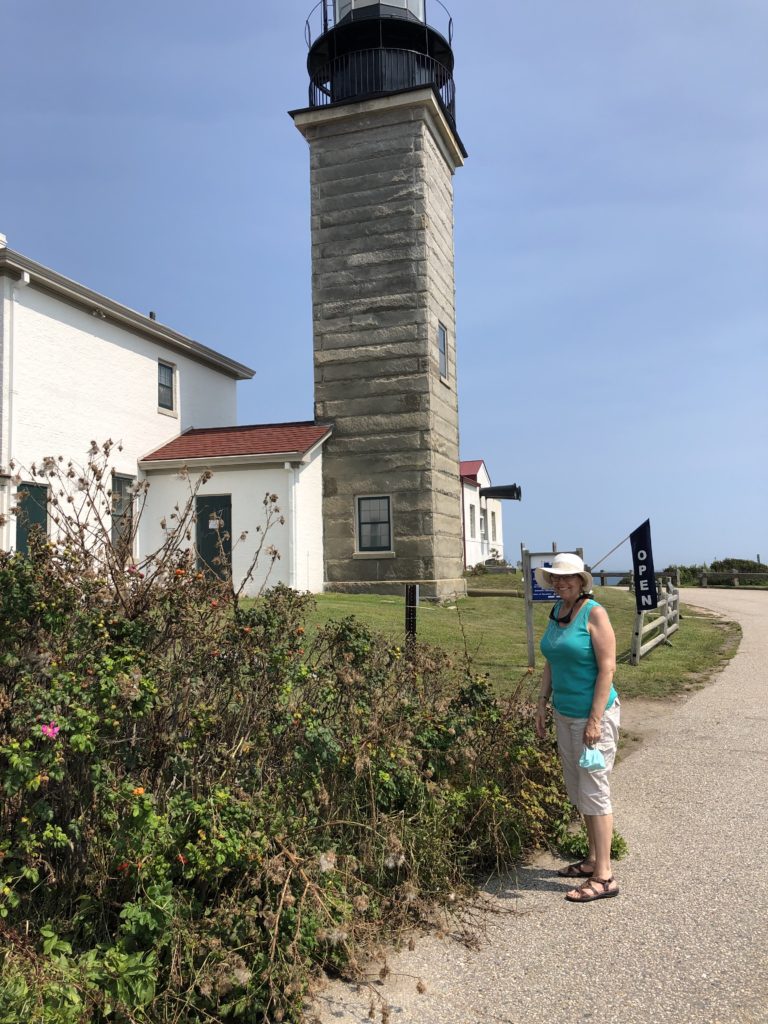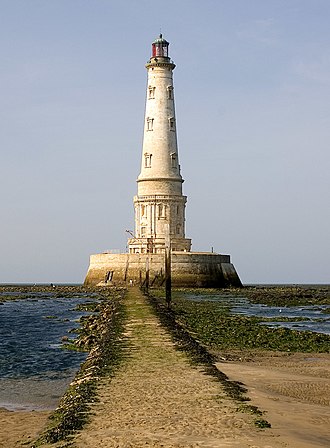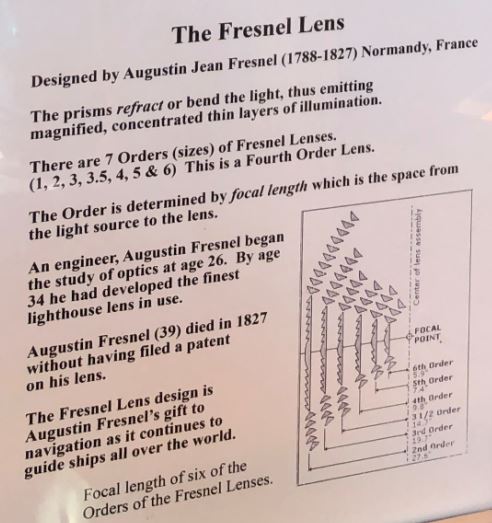If you follow this blog, you know I occasionally delve into the lives of lesser known individuals who made great contributions during our favorite time period. Since British and French scientists corresponded and compared notes despite the war which dominated the period, today we’re veering away from the UK to introduce you to a Frenchman who impacted every nation that had sea commerce in the early 19th century and hugely changed our knowledge about optical science. (Also I’m taking you to visit a tiny museum in the U.S.!!) What do lighthouses and the Regency period have in common?? Read on…
I happened across this “real Regency hero” back in August when fellow Risky sister Elena Greene and her two daughters stopped in for a quick visit with me. I live in “the ocean state” where we are, naturally, blessed with lots of shoreline and also lots of lighthouses.
The Beavertail Light on the island of Jamestown in Rhode Island was one of the earliest established in the American colonies. The original lighthouse, built in 1749, was only the third such structure in the country. The lighthouse standing there now is the third at that location (built in 1856) and also includes a small museum.
Always alert to a man in a cravat, on a wall there I encountered Monsieur Fresnel, a Regency era engineer and physicist who made great strides in the science of optics and in doing so, also invented the Fresnel lens. I wanted to know more!
Augustin-Jean Fresnel (1788-1827) was the second of four boys born to a French architect and his wife in the Normandy area of France. He was a sickly child (he suffered from tuberculosis) and did not show great promise in his early years when he was schooled (primarily in religion) at home. But in 1801 at age 13 he was sent with his elder brother Louis to the École Centrale at Caen. Fresnel’s aptitude for his studies improved there, and after three years he was accepted into the École Polytechnique, a prestigious school of higher learning south of Paris.
An uncle who was a prominent artist and professor at the school (Léonor Mérimée) took interest in Fresnel, who showed talent in drawing and geometry, winning a prize in geometry in his first year there. After he graduated in 1806, he went on to study engineering at the École Nationale des Ponts et Chaussées (National School of Bridges and Roads). He graduated in 1809, the same year his brother Louis, who had become a lieutenant in the French artillery, was killed in action in Spain.
Fresnel’s training led directly to employment as an engineer with the national Corps des Ponts et Chaussées, for whom he worked (with numerous approved leaves of absence) the rest of his life. A skilled and valued engineer, Fresnel also became a physicist due to an intellectual curiosity and natural ability for scientific inquiry that compelled him to continually question and test aspects of the world around him. His interest in optical science is what led to his greatest contributions to both scientific theory and practical applications that changed the world.
In the Beavertail Light Museum, Fresnel’s significance was reduced to a single, although important, card:
That really doesn’t tell us the story. He did so much more than this! How did he come to make this important invention, or develop the important theories about optics that changed so much science? As so often happens, a confluence of circumstances and timing helped out.
In 1814 after seeing a notice about work by French physicist Jean-Baptiste Biot (1774–1862), Fresnel’s curiosity about the nature of light and the science of optics was piqued and he began to study it and perform experiments on his own. A suspension from work (after he offered his services to the royalist cause during Bonaparte’s “100 Days”) ultimately gave him time off to further his studies.
There were two conflicting theories leading the optics field at this time. One was the “corpuscular theory” based on Descartes (1637) and favored by Isaac Newton, attributing a particle nature to light, and the other was the “wave theory” developed by Christiaan Huygens (1690). Neither theory could explain some of light’s observable phenomena—diffraction, for example, or polarization. No modifications in these 17th century theories had been proposed until the British polymath Thomas Young (1773–1829) published new work in 1801.
Lacking exposure to Young’s work, Fresnel duplicated much of that in his early experimentations. However, thanks to contacts through his uncle, Fresnel eventually met François Arago (1786–1853), one of several French physicists working in optic science at that time. While unimpressed with Fresnel’s first efforts, Arago did suggest readings and put him on a path to study Young’s work as well as other physicists developing optic theories, including Biot, André-Marie Ampère (1775–1836) and Étienne-Louis Malus (1775–1812).
Of these great minds, only Young favored Huygens’s wave theory, but Fresnel found much to like there. As he continued his explorations, he submitted papers to the Institute Polytechnique that were evaluated by Arago, who came to recognize that Fresnel was contributing new and important information to the field. Once Bonaparte was finally defeated in 1815, Fresnel was reinstated with the engineering corps, but his influence as a supporter of the winning side allowed him to obtain a leave of absence to continue his scientific work. When that expired, Arago intervened through his contacts to get Fresnel yet another leave, allowing him to come to Paris.
During this time Fresnel invented his famous double mirror lens as part of his experiments on diffraction. Between working and leaves of absence, Fresnel continued to work on his diffraction and other optic research and ultimately in 1819 won the prestigious Grand Prize awarded by the French Academy of Sciences.
His work on lighthouse lenses also benefited from circumstances and François Arago. In June, 1819, Fresnel was named to the Commission on Lighthouses, a body formed by Napoleon and administered by the Corps des Ponts, Fresnel’s employer. Arago, a member, recommended him. Fresnel had been working on a type of “stepped lens”, unaware that his work paralleled that being pursued by the British scientist David Brewster. When he made his first presentation on it to the commission in August, the similarities were pointed out, but Fresnel was still given a budget of 500 francs to have a prototype made, and when it was publicly demonstrated in 1820, it surpassed all other known lenses.
Fresnel went on to create both rotating and fixed lenses that surpassed his first design, while continuing to pursue the other optic theories he was developing. The rotating lens was tested publicly from atop the unfinished Arc de Triomphe in April 1822, witnessed by not only the commission members but also the king, at a distance of 32km. In 1823, the lens was installed in France’s oldest lighthouse, the Cordouan Light. Built in 1611, it still stands today, and with the extensions added in 1790, is the tenth tallest such lighthouse in the world as well as the last inhabited lighthouse left in France, although Fresnel’s lens was replaced in 1854.
Fresnel’s fixed lens was installed in the lighthouse at Dunkirk in 1825. Fresnel continued to improve on the design of his lighthouse lenses, offering several versions in different sizes; he also produced a mapped plan for equipping France with a system of 51 lighthouses where each would have a unique light pattern due to variations in the lens designs and sizes so that mariners could distinguish between them.
His health was deteriorating badly by this time, which only spurred him to work harder, pushed to complete his work before death should take him.
Fresnel contributed significantly to the science of optics and his development of the “transverse-wave theory” was credited by some as being as important to science as Newton’s gravitational theory. In 1825 he was elected to the Royal Society of London, and in 1827, he was awarded their prestigious Rumford Medal on the recommendation of John Herschel, with whom he had corresponded to answer questions about wave theory.
But Fresnel was dying from tuberculosis. Arago arrived to deliver the Rumford Medal to him just eight days before he died. But his legacy in marine safety was unmistakable: Wikipedia notes “Within a century of Fresnel’s initial stepped-lens proposal, more than 10,000 lights with Fresnel lenses were protecting lives and property around the world.” (ref. Levitt, 2013) And further, “Fresnel managed to construct the world’s first coherent theory of light, showing in retrospect that his methods are applicable to multiple types of waves.” Until the next advance in optic science (electromagnetism) was made by James Maxwell in 1865 and overshadowed Fresnel’s work, Fresnel’s discoveries were considered on a par with those of Isaac Newton in significance.
Did you know?
If you want more details (and can make sense of a lot of science), Wikipedia’s long biographical article offers a lot more information. And if you are curious about Fresnel’s lens, here is a close-up of the information at the Beavertail Light’s museum:








